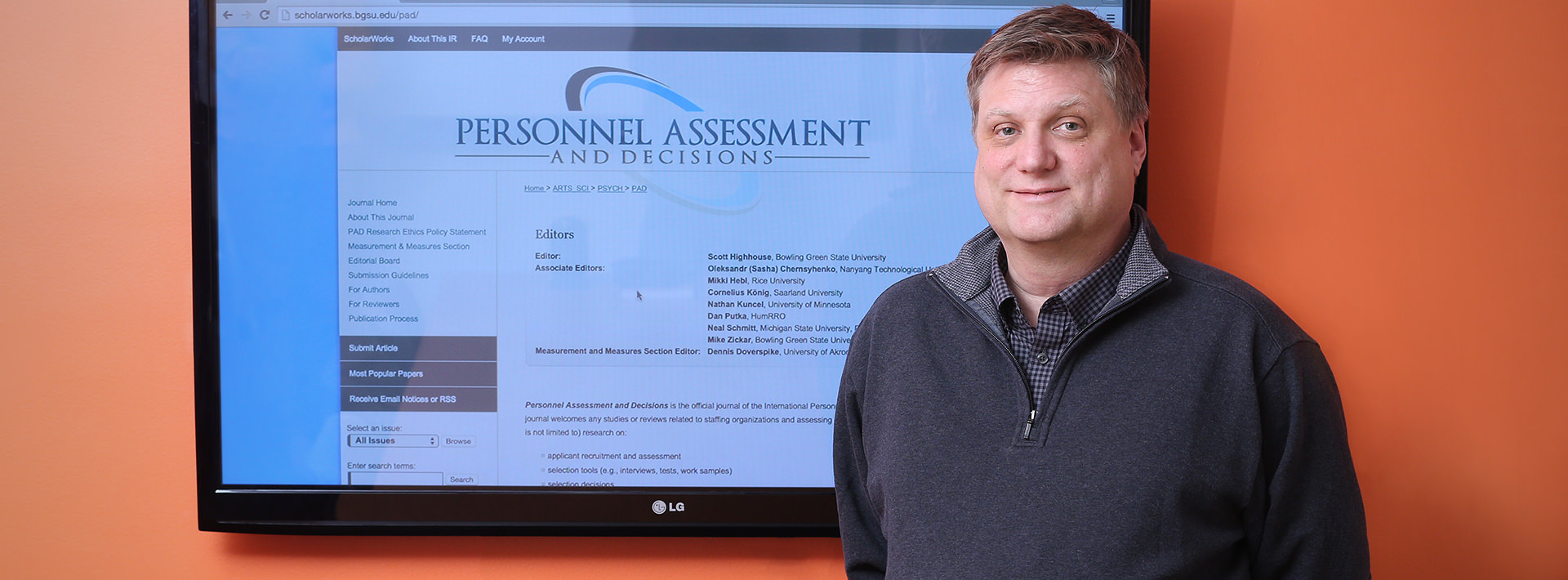Accessible research
BGSU launches open access I-O Psychology journal

By Michelle Harvey
Universities rely on scholarly journals. Faculty read them to further their knowledge, and they publish their own research in them so others can benefit from it.
But what if those journals are inaccessible or too esoteric to non-academics in the field? Such had been the case in industrial-organizational (I-O) psychology, which addresses workplace topics like employment selection tools, staff training and development, and job performance measures.
According to Dr. Michael Zickar, chair of the BGSU psychology department, 60 percent of those who get Ph.D.'s in psychology become practitioners, taking their knowledge out to the business world and losing access to university libraries that budget for expensive journal subscriptions. Add the fact that long, theory-based articles may not be as relevant outside of a university setting—not practical to the practitioner, so to speak—and that leaves a large portion of the profession disconnected from the literature.
“Practitioners have been cut out of traditional I-O psychology journals,” Zickar said. “They’re less likely to read and use the research.”
This was the thinking that led BGSU professor and Ohio Eminent Scholar Dr. Scott Highhouse, psychology, to launch in December 2015 the first open-access, peer-reviewed journal for I-O professionals. Highhouse, who is widely published himself and has held editorial roles with a variety of psychology journals, recognized the need for a new journal.
“The introduction of Personnel Assessment and Decisions (PAD) is based on the belief that publishing empirical research in industrial-organizational psychology must become quicker and leaner,” Highhouse said in the journal’s opening editorial. “It is also founded on the belief that we need a journal that publishes research that … is of interest to both scientists and practitioners.”
A member of the International Personnel Assessment Council (IPAC) board of directors, Highhouse knew that IPAC was looking to sponsor a new journal with funds donated by a long-term member. Around the same time, BG University Libraries instituted ScholarWorks@BGSU, an open access repository for digital, scholarly works created by faculty and students at the University, and was looking to begin hosting journals. PAD was the third to launch and the first that is peer-reviewed.
“Scholarly journals have hefty subscription fees and not everyone can afford to access the material,” said Dr. Colleen Boff, associate dean of University Libraries. “Open access is a shift in the publishing structure in which experts share their work for free. This is a great opportunity for the library to help facilitate this kind of scholarship while avoiding big fees.”
The animated real-time downloads feature on ScholarWorks@BGSU shows how many readers, and where they are from, have accessed which of the seven articles in this issue. Within a day of its launch, Personnel Assessment and Decisions had more than 65 article downloads, and has averaged about 150 downloads per week since then. Material has been accessed in more than 25 countries worldwide and because it is part of a larger repository system, the content is indexed in major search engines like Google Scholar.
In his blog “NeoAcademic,” Richard Landers of Old Dominion University wrote, “PAD has a submission model unlike anything else in our field.”
Indeed, PAD is a unique journal whose aim is to publish concise reports. At 4,000 words max, the articles are about half as long as those in traditional journals of empirical studies. It is geared toward a speedy review and publication process to allow new research to quickly become part of the discourse.
The first journal of its kind, Personnel Assessment and Decisions fills a niche in the discipline. Whereas scholarly journals tend to be theoretical with less direct impact in the business world, PAD’s concise articles get straight to the point with tightly focused articles on selecting, developing and evaluating employees, which are all highly relevant day-to-day topics for industrial-organizational psychologists working in the field. The journal’s readers and contributors are from both university and business settings, which is uncommon.
“The articles are of a really high quality for the first issue of a new publication,” said Zickar, who is also an associate editor of PAD. “The ScholarWorks@BGSU platform allows us to create a journal that looks and operates much like the expensive subscription journals, and because it’s peer-reviewed, it undergoes the same scientific scrutiny as any traditional journal.”
He also credits the journal’s success to a high-caliber editorial board and to authors with established credentials. The inaugural issue of PAD features some of the first publication of key work being done in the field.
Since the 1960s, BGSU has been known for its strong I-O psychology program. The introduction of Personnel Assessment and Decisions reinforces that reputation and gives the University even greater visibility among industrial-organizational psychology professionals.
Updated: 12/02/2017 12:28AM
